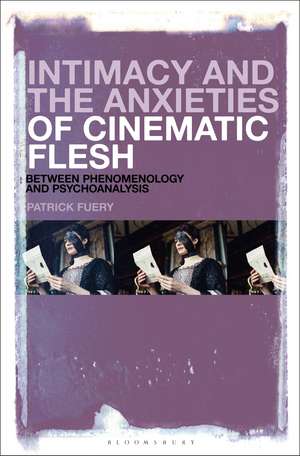Intimacy and the Anxieties of Cinematic Flesh: Between Phenomenology and Psychoanalysis
Autor Professor Patrick Fueryen Limba Engleză Hardback – 22 feb 2023
| Toate formatele și edițiile | Preț | Express |
|---|---|---|
| Paperback (1) | 191.75 lei 3-5 săpt. | |
| Bloomsbury Publishing – 21 aug 2024 | 191.75 lei 3-5 săpt. | |
| Hardback (1) | 539.99 lei 6-8 săpt. | |
| Bloomsbury Publishing – 22 feb 2023 | 539.99 lei 6-8 săpt. |
Preț: 539.99 lei
Preț vechi: 773.79 lei
-30% Nou
Puncte Express: 810
Preț estimativ în valută:
103.32€ • 107.88$ • 85.52£
103.32€ • 107.88$ • 85.52£
Carte tipărită la comandă
Livrare economică 04-18 aprilie
Preluare comenzi: 021 569.72.76
Specificații
ISBN-13: 9781501376351
ISBN-10: 1501376357
Pagini: 264
Ilustrații: 25 bw illus, 2 Figures
Dimensiuni: 152 x 229 mm
Greutate: 0.52 kg
Editura: Bloomsbury Publishing
Colecția Bloomsbury Academic
Locul publicării:New York, United States
ISBN-10: 1501376357
Pagini: 264
Ilustrații: 25 bw illus, 2 Figures
Dimensiuni: 152 x 229 mm
Greutate: 0.52 kg
Editura: Bloomsbury Publishing
Colecția Bloomsbury Academic
Locul publicării:New York, United States
Caracteristici
Combines two theoretical approaches to cinema that have more often than not been seen as opposed: phenomenological and psychoanalytic
Notă biografică
Patrick Fuery is Director and Professor of the Center for Creative and Cultural Industries, Chapman University, USA. He was previously Reader in Film, Royal Holloway, University of London, Professor of Film, Sussex University, UK. He is the author of 8 books in the areas of film, psychoanalysis, phenomenology, cultural theory, and visual cultures. He is currently working on a book on the phenomenology and psychoanalysis of wildness.
Cuprins
DedicationPrefaceAcknowledgementsWhere Intimacy-Anxiety Was, There (Cinematic) Flesh Shall Become: Towards an Introduction1. The Intimate Spectator, the Cinematic Ego, and the Nothing (to be Anxious About)2. Cinema's Enduring Object and Time3. Four Modalities of Intimate and Anxious (Cinematic) Space4. Shading the Real: Cinema's Sensual Phantasms5. Passionate Abnormalities and the Disturbances of Wildness6. The Desire to not be Protected: Breathless Desires of the NightmareBibliographyIndex
Recenzii
The book offers a rare combination of phenomenology and psychoanalysis in describing what we do when view a film. The viewer emerges as the anxiously intimate spectator without whose responses cinema could not exist. Interweaving his theorization with a rich offering of film analyses, the author is inviting us to test our own cinematic experience against the book's interpretations.
In this scintillating work, Patrick Fuery argues that film creates a new ego and cinema becomes not simply a different art form but an entirely new way of being, experiencing, and knowing. The cinema ego is sensuous and sentient. It creates new object relations and invites different terms - "the projected familiar," "introjected defamiliarization" that open different intellectual and emotional vistas. "To be a film spectator," he writes, "is to take up an othered consciousness," and this brave and brilliant book provides its readers with the conceptual tools to engage this new otherness. A work for all of us to read.
An extraordinary book and compulsory reading for all those interested in the visual history of the human body.
In this scintillating work, Patrick Fuery argues that film creates a new ego and cinema becomes not simply a different art form but an entirely new way of being, experiencing, and knowing. The cinema ego is sensuous and sentient. It creates new object relations and invites different terms - "the projected familiar," "introjected defamiliarization" that open different intellectual and emotional vistas. "To be a film spectator," he writes, "is to take up an othered consciousness," and this brave and brilliant book provides its readers with the conceptual tools to engage this new otherness. A work for all of us to read.
An extraordinary book and compulsory reading for all those interested in the visual history of the human body.
